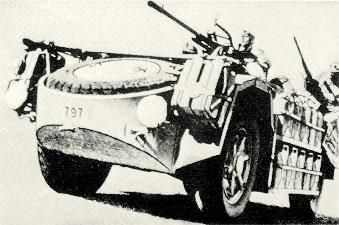Effectiveness of Guns and typical AFV Ammo Loads in British Service (including some U.S. Types).
This is a 1944 British War Office Document.
Continue reading “Effectiveness of British (& U.S.) Tank Guns”
A Passion for History, Miniatures, & Gaming
Effectiveness of Guns and typical AFV Ammo Loads in British Service (including some U.S. Types).
This is a 1944 British War Office Document.
Continue reading “Effectiveness of British (& U.S.) Tank Guns”
The penetration of AP (Armour Piercing) Shot is determined primarily by its weight and velocity at the moment of impact. Other factors can influence it’s velocity (such as wind, pressure and atmospherics), or its ability to “bite” into the armour (e.g. ballistically curved surfaces, such as the T-34 turret or Porsche King Tiger Mantlet, or different shaped projectile heads, can cause rounds to ricochet). Finally the angle of the target’s armour, along with the firer’s angle of shot can affect the relative thickness of armour presented to the round that will need to be penetrated.
Continue reading “Determining Shot Penetration Characteristics”


The Angle of Impact on Armour Plate with the Angle of Attack in the Horizontal Plane
Formula: Cosine (Compound Angle) = Cosine (Vertical Angle) x Cosine (Horizontal Angle)
This information above was supplied to me by Jim O’Neil (Arizona, USA), the original source was Lorrin Bird. I’ve added a couple of quick comments below in the Notes section.
An increase in the hardness of a given thickness of homogeneous armour may result in an increase or in a decrease or in no change at all in resistance to penetration, depending upon the ratio of the thickness of the armour to the calibre of the projectile concerned. Where under-matching projectiles (those whose calibre is less than the thickness of the armour) are concerned resistance to penetration at normal impact increases as hardness increases; where overmatching projectiles (those whose calibre is greater than the thickness of the armour) are concerned, resistance to penetration at normal impact decreases as hardness increases; and where matching projectiles (those whose calibre equals the thickness of the armour) are concerned, little change in resistance to penetration at normal impact occurs over a considerable range in hardness.
Continue reading “Effect of Hardness upon resistance to Penetration”
Figure scales are expressed two ways, either as a simple measurement, e.g. 25mm, defining how high a figure of a normal man or woman stands or as a ratio, e.g. 1/48th, defining how big a model vehicle, vessel, aircraft, or construction is in relation to the real thing. The emphasis here is on the former classification with the latter provided where possible as an approximate comparison.
Continue reading “Wargaming Scales”The following is a brief history of modern wargaming told in quotes from various wargaming books & authors:
“It was in Europe that the early forms of wargaming gradually took on a more sophisticated appearance. During the Seventeenth Century several variations on the basic game of chess were introduced. During the Eighteenth Century a number of games were introduced into France which departed from the idea of pieces and which used series of cards designed to impart basic military knowledge to the players. Also, at about this time, silver model soldiers were being used at the French Court to instruct the future king, Louis XIV, in the art of war” – David Nash (Wargames – 1974).
Continue reading “Brief History Of Wargaming”Periods are the “Eras” or “Level of Technology” present for wargaming. Having a Greek Army of 300 BC facing a Russian Army of 1944 AD is obviously quite a mismatch and both armies need quite different sets of rules to control how they perform. Hence we have “Periods” in which armies all operated in similar ways, or with similar weapons, and can be ‘played’ using a common set of rules.
Continue reading “Wargaming Periods”1st Armoured Division, WDA.
Formed July 1942.

As used by Italian Reconnaissance Groups
Officially the Camionetta 42 ‘Sahariana’ – however, they are also referred to as – Camionetta ‘Sahariana’ AS 42 – or – Camionetta SPA 43 ‘Sahariana’ – (and incidentally the word Sahariana is singular, so if you are talking about more that 1 vehicle it is ‘Sahariane’).
The letters AS are the Italian code for North Africa, “Africa Settentrionale“, which pretty literally translates as “North African” but is often translated as “African Service” in English texts. Any equipment, unit organization, or formation that was designed or organized specially for North Africa was given this designation. In this case, it refers to the mechanical specifications of the vehicle being able to handle the harsh environment.
(at Bir el Gubi, November 1941)
GRUPPO GGFF HEADQUARTERS COMPANY
GRUPPO GGFF MG COMPANY
COY HQ
3 MG PLATOONS (each 3 x MMGs)
Continue reading “Giovani Fascisti: The “Young Fascists” (GGFF)”
The MVSN started out as an organization not unlike the German S.A. (Brown Shirts), i.e. a Fascist Militia. They were purely a “Party” orientated organization, and like their German Counterparts wore a distinctive uniform – a Black Shirt and a Fez. This led to their popular nickname of Black Shirts (Camicie Nere – Camicie = Shirt & Nere = Black). Later the term CCNN was adopted for Black Shirt military units, and is taken directly from the initials of Camicie Nere. MVSN and CCNN are generally interchangeable, however the former primarily refers to political orientated parts of the Black Shirts, while the latter is generally used in reference to combat units.
Continue reading “Camicie Nere: The Blackshirts (MVSN & CCNN Combat Units)”